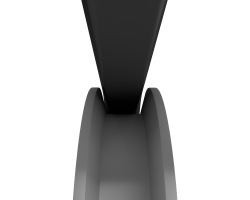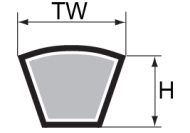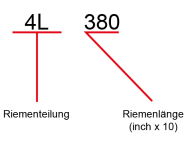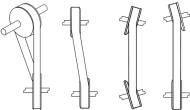3L/4L/5L
FHP belts are used in the agricultural machinery industry and in the world of garden machinery.
Properties
- Ideal for light loads
- Suitable for miniature motor drives
- Top-performing when operating with reverse idler pulleys
- Outer belt sleeve ensures smooth, low-noise operation with only minimal vibration
- Heat-resistant and oil-resistant
- Electrically conductive
Application:
- The agricultural machinery industry
- The garden machinery industry
| Typ | TW | H | ||
| Inch | mm | Inch | mm | |
| 3L | 3/8 | 9,5 | 7/32 | 5,5 |
| 4L | 1/2 | 12,7 | 5/16 | 7,9 |
| 5L | 21/32 | 16,5 | 3/8 | 9,5 |
| Available belt pitches | 3L | 4L | 5L | |||
| Belt type | mantled | |||||
| Doouble V-Belt available? | no | no | no | |||
| Tolerance according to: | MBL | |||||
| Belt material | Rubber | Rubber | ||||
| Tensile member | Polyester | |||||
| fabric | Cotton | |||||
| electrical conductivity | yes | |||||
| Temperature-range | -40 ~ +70 | |||||
| Wear resistance | normal | |||||
| Heat resistance | normal | |||||
| max. belt speed | (m/s) | 25 | ||||
| Weight | (kg/m) | 0.12 | 0.20 | 0.35 | ||
| available lengths | (inch) | 20-76 | 20-99 | 20-99 | ||
3L/4L/5L Order Reference
| Standard belt size (inch) |
||
| Belt type | Size range | |
| 3L | 200-790 | |
| 4L | 210-1000 | |
| 5L | 230-800 | |
| Minimum pulley size FHP belt(mm) | |||||
| Belt type | Recommended minimum dimension of pulley size | Permitted minimum dimension of pulley size | |||
| Outer diameter |
Pitch diameter |
Outer diameter |
Pitch diameter |
||
| 3L | 84 | 75 | 64 | 55 | |
| 4L | 106 | 95 | 86 | 75 | |
| 5L | 134 | 120 | 114 | 100 | |
Alongside our wide standard range of this product, we also craft in our ateliers high-precision drawing parts and customised special pulley washers. With all our products we offer a comprehensive service ranging from the manufacturing of mechanical processing parts and gearing components right up to the mounting of finished systems and assembly units.
Pre-Tensioning The Belt Correctly
Firstly the belt always has to be tightened in line with the calculated pre-tensioning force and checked after a running-in period of about 5 minutes. The belt is then to be retightened according to the relevant value, should it have shifted or altered its position in any way. Finally after a further 8 hours of operating, the belt is to be once again inspected and, if necessary, tightened to comply with the required value that has already been calculated.
Causes of failure and corrective measures can be found in the following document:
Troubleshooting for power transmission products






















